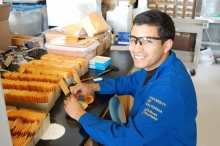
Major:
Mentor(s):
Faculty Sponsor(s):
Faculty Sponsor's Department(s):
Project Title:
Project Description:
Species and populations may differ from one another due to either environmentally induced differences, genetic differences, or both. Our research aims to detect whether two closely related species of California wildflowers, Clarkia unguiculata and C. exilis, are genetically distinct with respect to three ecologically important traits: seed mass, flowering time, and ovule number per flower. A greenhouse experiment was conducted to detect geneticallybased variation within and among populations of each species. In addition, to evaluate whether these traits may evolve independently of each other, we measured genetically based covariation between each pair of traits within and between both taxa. Seeds produced by >950 plants representing 11 wild populations were raised and measured. Differences in all three traits observed between these species in the wild persist when they are grown in a common environment, indicating that the differences are genetically based. In both species, we found a significant, genetically-based correlation between seed mass and flowering time that may prevent the independent evolution of these two traits. Differences in seed mass between these species are also associated with differences in the elevation of wild populations; C.exilis produces smaller seeds and occurs at lower elevations than unguiculata. The relationship among populations between elevation and seed mass was non-significant, but we detected a significant positive relationship between elevation and flowering time (low-elevation populations flower relatively early). These results imply that, if conditions in California become hotter and drier, then wild unguiculata populations may evolve earlier flowering and smaller seeds, which may pose ecological risks.
